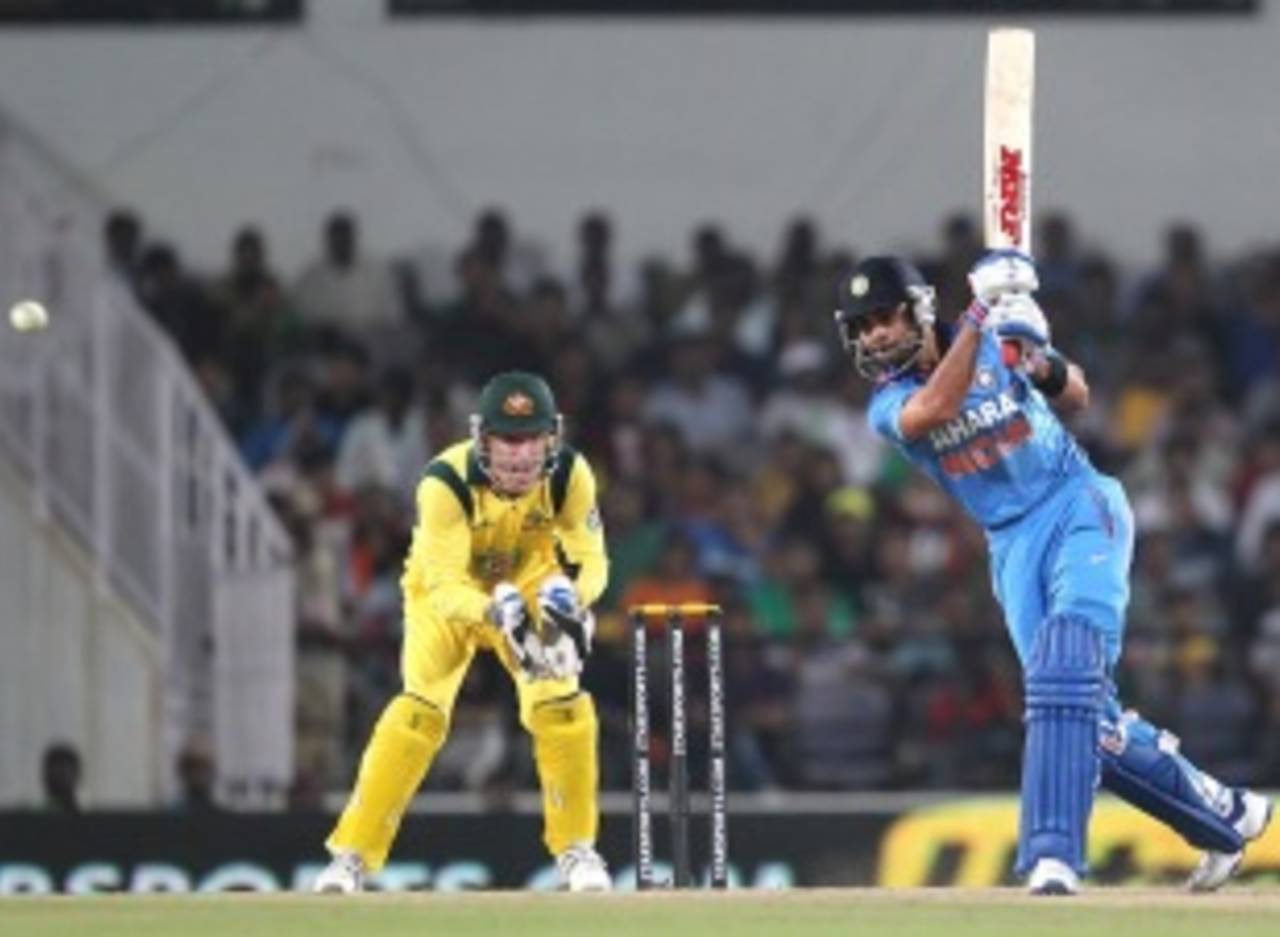The champion of the chase
Virat Kohli's phenomenal success in ODI chases is largely due to his ability to play percentage cricket at a frenetic pace. He hit only one six in his 115 off 66 balls in Nagpur
Sidharth Monga
31-Oct-2013

Virat Kohli did not need sixes to maintain a startling strike rate in Nagpur • BCCI
Virat Kohli now has 11 hundreds in 64 innings he has batted in ODI chases. Sachin Tendulkar, the only man ahead of Kohli, holds the record with 17 in 232 second innings, but the real perspective can be drawn by looking at whom Kohli is tied with: his friend, Royal Challengers Bangalore team-mate and West Indies opener Chris Gayle, who has taken 132 innings to score 11 centuries in ODI chases. And Kohli is not even an opener, in fact four of his 11 hundreds have come at No. 4.
Even after making allowances for heavy bats, smaller and quicker outfields, new fielding regulations, general decline in bowling, advent of Twenty20, global warming and whatever else, these are scary numbers and a huge improvement over players who have been, for a significant portion of their careers, Kohli's contemporaries.
In his 64 chases, Kohli has remained unbeaten on less than 100 in eight wins, which effectively reduces his hundred-scoring rate to one in every five innings where scoring a century is possible.
"I sort of like batting under lights," Kohli said. "If I have a target on the board, it is always easy to analyse how many runs you need in, say, a Powerplay, or what sort of situation you are playing in. I always like a target on board and sort of analyse my game and sort out how I want to go about it."
His last two hundreds in chases have come in 52 and 61 balls, India's fastest and third-fastest centuries. Only two other batsmen have scored more than one century in less than 65 balls: Shahid Afridi and Sanath Jayasuriya. They did not have the technique Kohli does, and they had to take risks while pursuing those strike-rates.
In playing proper cricket shots while notching up these staggering numbers, in demoralising oppositions by going at such a rate by playing percentage cricket, is Kohli's genius. He has all the shots, which gives him the confidence to back his game even when he is taking his time at the start of his innings. Where he tellingly scores over his contemporaries - who are becoming more adept at clearing fields and relying less on the single - is that he still hates playing dot balls.
In his last two chases, Kohli reduced his number of dot balls hit risk-free boundaries. During his 115 off 66 balls in Nagpur, Kohli hit only one six. He didn't need to hit more. There are few things more disheartening for an opposition captain than a batsman who doesn't need to hit in the air to score at a strike rate of 174. Kohli took a risk only at the start of his innings, when he slog-swept a six, and after he began timing the ball sweetly he went back to playing percentage cricket.
At the end of the match George Bailey, the opposition captain, made an interesting point. He said his bowlers had at least forced Kohli to use his best shots. He played them after Mitchell Johnson had picked up his bunnies, Yuvraj Singh and Suresh Raina, and after MS Dhoni had realised how easy Kohli was making batting look.
India needed 35 in three overs, the most challenging the chase of 351 had got. James Faulkner was to bowl the 48th over. In the 46th, he had beaten Dhoni's bat three times with deliveries that went against the angle from round the stumps. He had also drawn a thick outside edge that went for four. This was where Kohli would be tested. "You are making me play good shots," Kohli seemed to say. "I will play the good shots."
To the first ball off the 48th over, Kohli charged out, took it at chest height, and drove it - yes, drove it - to wide long-off for four. Bailey sent another man there, and Kohli took a slightly fuller delivery two balls later and flicked it between long-on and deep midwicket. The game was back in India's grasp.
"When Mitchell Johnson came back, it helps to have someone of the experience of MS," Kohli said about that period of play. "He said, 'He has come for wickets, let's play him out, and one of the other overs can be the big one.' I had confidence in my ability and the sort of pace I was setting that I could clear fielders." It's that confidence that he has, that Dhoni has, which helps Kohli keep calm during the quiet periods. On evidence of his ODI career so far, the confidence is not misplaced.
Sidharth Monga is an assistant editor at ESPNcricinfo